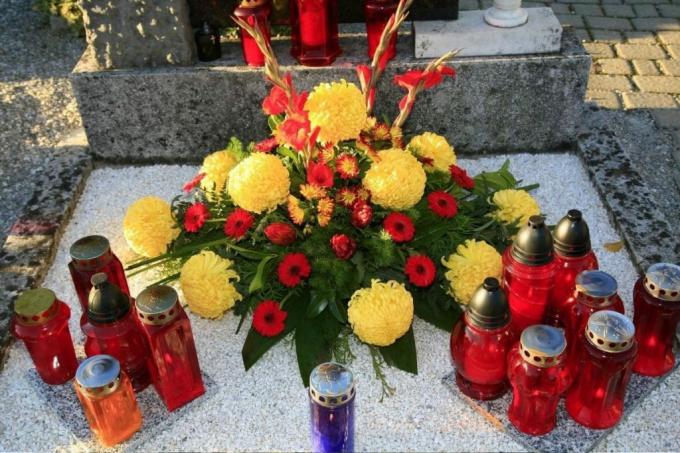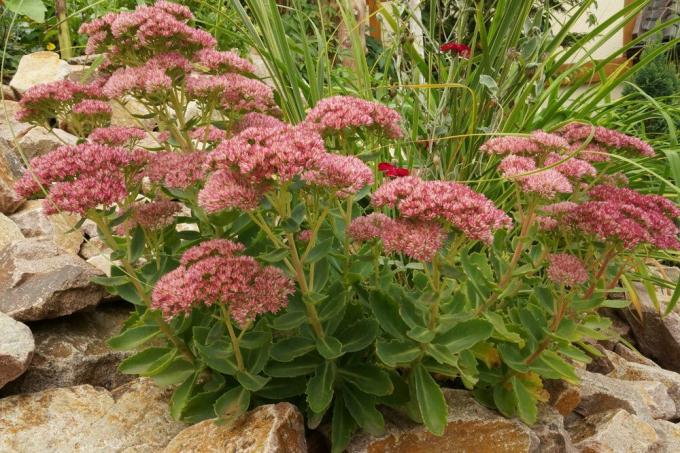
table of contents
- Mulch and pebbles
- Colors and size
- Grave design
- Complete coverage
- Partial coverage
- Plan, prepare and create
- Grave plants
- Ground cover
- Perennial perennials
- frequently asked Questions
A well-tended and tidy grave is a “must” in this country. However, the effort often exceeds the time budget. With gravel and mulch, the grave design is durable and easy to care for.
In a nutshell
- Gravel and mulch make the grave easy to care for
- different grain sizes and colors available in stores
- not every cemetery administration allows the materials on the grave area
- pay attention to the height of the plants
- Ground cover and / or perennial shrubs are particularly easy to care for
Mulch and pebbles
A fully planted grave may look pretty, but it also requires appropriate care. On the one hand, the grave has to be cleared of weeds, and on the other hand, the plants need regular watering when the rain fails. This means an enormous amount of time and care for the bereaved. If the cemetery is further away, it seems almost impossible to keep a fully planted grave tidy.

Bark mulch and gravel are one way of reducing the maintenance effort and still having a well-tended grave. Because both materials have the property of drastically reducing the growth of weeds. In addition, a layer of mulch protects the soil from drying out quickly. So there is less need to pour. In addition, both materials are durable.
Colors and size
You can find decorative gravel or Decorative split in different sizes and colors. White stones are considered to be very noble. Gray gravel is less noticeable. But there are also colored stones or decorative gravel in natural brown tones. In the case of mulch, the choice of colors is significantly smaller. There are differences here, too, but they are always lighter or darker (red) brown tones. The grain varies. Coarser mulch has a grain size of 0 to 8 centimeters, finer bark mulch between 0 and 3 centimeters. The latter is also known as Dekomulch. However, this has no effect on the properties.
Grave design
When designing the grave with gravel and bark mulch, you basically have three options:
- Cover the entire grave area with one of the two materials
- Cover parts of the grave area with ornamental gravel or bark mulch
- a combination of both materials for different areas on the grave
Note: Before you start designing the grave, you should inquire with the cemetery administration whether gravel and / or bark mulch are allowed on the grave area.
Complete coverage
Covering the entire grave area is only recommended for ornamental gravel. Because the grave can be designed well with different grain sizes and colors. Bowls with plants, which can be designed according to the season, provide a splash of color. However, you should note that plants that are placed in bowls require regular care. Therefore, this solution is by no means easy to care for.

Partial coverage
Partial covering is recommended so that the grave is actually easy to care for. When designing the grave, parts of the area are covered with decorative gravel, gravel or mulch and others are planted. In order to use the positive properties of the bark mulch, a layer of bark mulch can also be applied to the planted areas. Then there is a combination of ornamental gravel, bark mulch and plants.
Plan, prepare and create
The design of the grave area requires a certain amount of planning, because once the gravel split has been applied, it is laborious to "collect" it again or to exchange it. Ideally, you will create several sketches for the design of the grave. Sample graves as examples can serve as templates or ideas. You are free to choose the shape of the gravel surfaces, unless the cemetery administration has guidelines. They can be round, square or wavy.
Before you can deploy either or both of the materials, the grave needs to be prepared. Because the earth subsides after the burial, you should not begin preparation until six months after the burial. So that the grave does not look neglected during this waiting period, you can put fresh flowers or arrangements on it. If the waiting period ends in winter, wait until the ground is no longer frozen before preparing. That makes work easier. Follow these steps:
- Excavate the grave area about 25 centimeters
- Remove weeds, (old) roots and stones
- dig up well
- Undermine sand or gravel (drainage function)
Now you can lay out the grave according to your sketch.
- Cover gravel areas with plant fleece (against weeds)
- alternatively: cover the entire grave area with fleece, cut crosses for plants
- Gravel or Pour earth areas
- Planting plants
- Water the plants
- Cover soil areas with mulch

Tip: If the earth areas are planned in the middle of the grave, then you should finish them first and only then apply the gravel.
Grave plants
Since ornamental gravel and bark mulch ensure that the grave is easy to care for, you should plant easy-care plants to keep it that way. It is important that the plants can tolerate drought so that the watering effort is kept within limits. With regard to the height of growth, you should inquire in advance with the cemetery administration which heights are allowed.
Ground cover
Since ground covers are long-lasting and prevent weeds from growing, they are ideal for an easy-care grave. Many ground covers are suitable for designing graves, such as:
-
Sedum (sedum): winter or evergreen, sun to partial shade, flowers of different colors
-
Yellow rock cress (Arabis ferdinandi-coburgii "Old Gold"): Evergreen, sun (preferred) to shade, white flowers, yellow-green leaves
-
Cherry laurel (Prunus laurocerasus "Mount Vernon"): evergreen, sun to partial shade, white flowers (rare)
-
Matt green plumage (lye flower (Cotula dioica): Evergreen, sun to partial shade, yolk yellow flowers
- Japanese azalea (Rhododendron obtusum): pure white to ruby red, large flowers characterize the Japanese azalea from late May to mid-June. It is particularly suitable for designing graves, as its growth rate is only a few centimeters per year. The winter or evergreen plants grow in sunny to partially shaded locations and reach heights of up to 30 centimeters.

Perennial perennials
The range of perennial perennials is large. There are also different heights of growth within the individual species. That is why you should pay attention to the variety. Examples are:
-
Real lavender (Lavendula angustifolia): white or purple flowers from July to Augst, growth height up to 30 centimeters (e. E.g.: "Blue Scent", "Ellagance Purple", "Nana Alba"), sunny location
-
Lady's mantle (Alchemilla alpina): Greenish-yellow, rather inconspicuous flowers from June to September, height of growth up to 15 centimeters, sunny location
-
Luminous coneflower (Rudbeckia fulgida): golden yellow flowers from August to October, up to 50 centimeters in height, in a sunny location
-
Sun hat (false sun hat, hedgehog heads; Echinacea): white to purple flowers from July to September, up to 50 centimeters in height, in a sunny location
- Anemone nemorosa, A. ranunculoides, A. sylvestris): white, golden yellow, purple-red to light violet-blue in spring, height of growth up to 30 centimeters, partial shade to sun

Tip: To add colorful accents from spring to autumn, you should combine early and late flowering perennials.
frequently asked Questions
Yes. The different colors are purely optical and have no influence on the function of quality goods.
Provided that the cemetery administration allows this, you can also cover individual parts of the grave area with bark mulch.
Basically yes, but in this case you have to cut the plant protection fleece crosswise at the appropriate places so that the plants can take root in the soil.
